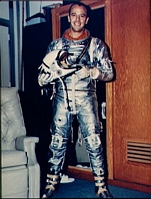|
|

|
Alan Bartlett Shepard
Astronaut and Chief of the Astronaut Office
|
Born: November 18, 1923
Birth Place: Derry, New Hampshire
Died: July 22, 1998
Cause of Death: Natural causes (Leukemia)
Date Joined NASA: April 2, 1959
Year Left NASA: 1974
Space Flights: 2
Time in Space: 9.01 days
Number of EVAs: 3
Total EVA Time: 9.42 hours
|

Alan Shepard
|
MISSION ASSIGNMENTS
- Mercury MR-3A
Assignment: Proposed Prime Crew
MR-3A was launched as an unmanned test flight at the last minute. Shepards flight was posponed which resulted in the Russians beating the United States into space.
- Mercury MR-3 "Freedom 7"
Assignment: Prime Crew
Flight Duration: 0.01 days (about 15 minutes)
- Mercury 9 "Faith 7"
Assignment: Backup Crew
- Mercury 10
Assignment: Proposed Prime Crew
NASA decided to end the Mercury program after Mercury 9 resulting in the cancellation of this mission.
- Apollo 14
Assignment: Prime Crew
Flight Duration: 9 days
HIGHLIGHTS
-
After graduating from Annapolis, Shepard was assigned to
the destroyer Cogswell which was stationed in the
Pacific during World War II. He received his wings in
1947 after training at Corpus Christi, Texas, and
Pensacola, Florida. His next assignment was with
Fighter Squadron 42 at Norfolk, Virginia, and
Jacksonville, Florida. He served several tours aboard
aircraft carriers in the Mediterranean while with this
squadron.
-
In 1950, he attended the United States Navy Test Pilot
School at Patuxent River, Maryland. After graduation,
he participated in flight test work for the Navy. He
has logged more than 8,000 hours flying time, which
includes 3,700 hours in jet aircraft.
-
Chosen by NASA as one of the original seven astronauts
in Arpil, 1959. He became the first American to journey
into space on May 5, 1961. Shepards spacecraft was
launched on a ballistic trajectory suborbital flight
which carried him to an altitude of 116 miles and 302
miles from the launch site.
-
He was designated the Chief of the Astronaut Office in
1963 after an inner ear disorder grounded him. This new
position gave him the responsibility for monitoring and
coordinating all NASA activities involving astronauts.
-
After surgery to correct the inner ear disorder Shepard
was restored to full flight status in May 1969. He was
assigned the Commander of Apollo 14, and began his
second spaceflight on January 31, 1971 along with
crewmates Stu Roosa and Edgar Mitchell. Shepard and
Mitchell collected over 100 pounds of lunar samples for
return to Earth, more that any other Apollo mission.
-
Shepard resumed his duties as Chief of the Astronaut
Office after returning to Earth and remained in that
role until he retired from NASA and the Navy on
August 1, 1974. He held the rank of Rear Admiral in the
Navy.
-
He was involved in private business activities in
Houston that had made him a millionaire even before he
had left NASA. He also served as the President of the
Mercury Seven Foundation, a non-profit organization
which provides college science scholarships for
deserving students.
Information provided by Mark Wades Encyclopedia Astronautica
http://www.friends-partners.org/mwade/spaceflt.htm
|
|
|

